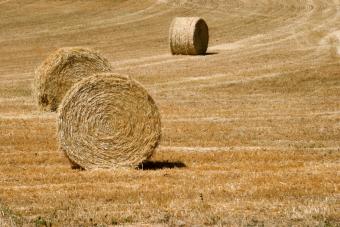La ferme

Le champ (the field) pictured here, is of la terre fertile, (fertile land). No doubt, this land produces many les cultures (crops) such as le blé (wheat).
Le tracteur

A farm takes a lot of machinery to run. Le fermier (the farmer), uses le tracteur (the tractor) to ready le terroir (the soil) for planting. Other machines you might see on a working farm include:
- la moissonneuse-batteuse (combine harvester)
- la charrue (plough)
- le semoir (a seed sower)
La grange rouge

Many farms have une grange rouge (a red barn). Horses are kept in l'écurie (the stable), pigs live in une porcherie (pigsty), and cows are kept in l'étable (cattle shed).
Les vaches

At une ferme laitière (a dairy farm), you are likely to see les vaches (cows), in addition to other barnyard animals. A dairy farm will produce mainly, le lait (milk), la beurre (butter), and le fromage (cheese).
Le poulet

Raising les poulet (chickens), doesn't always have to happen on a farm, but many farmers keep chickens for their les oeufs (eggs). Other birds you might see on a farm would include:
- une poule (a hen)
- un canard (a duck)
- a goose (une oie)
Les lamas

Les lamas are often bred on farms and their fur is used to make warm sweaters, mittens and scarves. Farmers might keep les moutons, sheep for their la laine (wool), as well.
Sign up for our newsletter featuring all the latest stories and products we love.
Un poulain

The birth of un poulain (a foal) on a farm is a major event. In fact, the birth of any baby farm animals is always a springtime event--sometimes even warranting a call from a neighbor or two to help. Other baby animals include:
- un veau (a calf)
- un agneau (a lamb)
- un porcelet (piglet)
French Farmland

French farms export mostly le vin (wine), le sucre (sugar), le beouf (beef), and le blé (wheat). L'agriculture (agriculture), in France is noted for its excellence and France exports more agricultural products than any other European nation. No doubt, there lie substantial amounts of French Countryside that is pristine and meticulously kept!







